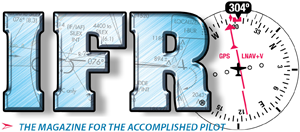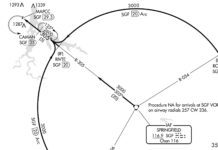Low IMC approaches are often the highest-workload procedure for single-pilot, single-engine flights. But departures can be a handful, especially when the weather is between VMC and IMC. Counterintuitive, yes. That’s because there’s more than one option in addition to flying an IFR published procedure. Visual departures followed by IFR routing, obstacle departure procedures (ODPs) that combine visual and instruments—you get the idea.
Awesome Arrival
And like today’s flight, the mission can complicate things further. It’s an LIFR approach at Williamsport, Pennsylvania, (KIPT). You’ve been there before for avionics work in your four-seat (realistically two-seat) Piper Cherokee. But this time, you’ll fly out with a replacement autopilot. It’s nearly identical to the one that went inop a few weeks back, so you’re familiar with its use. Since the first visit was under VFR and you landed on Runway 9, this trip will be IFR, ending with the RNAV 27.
This approach has LNAV and circling mins, and a little surprise: two LPV Decision Altitudes. The first is “DA#” of 777-¾ and the next, “DA” of 811-¾, just 34 feet apart. Gotta read the notes.
There are two: “Inop table does not apply to LPV DA#.” And, on the missed approach, DA# “requires minimum climb of 353 feet per NM to 1300.” The Inoperative Components Table that increases minimums if approach lighting is out, won’t apply. Meanwhile, for the missed approach, “DA” mins should be okay for the expected 400-foot overcast.
But because it’s close, you wanna know if the DA# missed is workable. At 75 knots groundspeed (1.25 miles per minute) the required 353 feet per nautical mile is 441 fpm in no wind. Since you’re confident of 600 fpm flying light on a cold day, there’s no problem.
Comfortable with the arrival, you get cleared to Williamsport, with vectors for HULRO, an IAF for the RNAV 27. When Tower greets you, the ASOS says the ceiling has dipped to 300 feet broken, visibility four miles. With the ground at 528 feet, both LPV DAs should work, but you’re close to the higher DA of 811 feet. Continuing is okay as long as the visibility is at least ¾ SM. With the report of four miles, you ought to see the runway and lighting once below the ceiling.
And, you’ve briefed just for this situation. If you don’t have the full runway and its markings clearly in sight at 800 feet indicated, you’ll execute the DA# missed approach, which might start with a slight dip to 780 feet as you go to full-power. This cushion goes unused as you break out of a gap in the clouds at 850 feet. Still, your plan was good insurance, allowing you to arrive relaxed enough to grease it on and taxi to the ramp, where a one-way rental car awaits for the drive home.
Getting Overhead
A few weeks later the Piper’s back in service with the new autopilot. You drive back to Williamsport anticipating a fully coupled flight home. It’ll come in handy as the ceiling’s 1500 overcast, visibility eight miles. This seems like a nice IFR flight back with tops around 3000 feet.
Today is different, though; it’s a post-maintenance flight, so IMC is not the best place to try out new equipment or troubleshoot a loose wire. While most of us take extra care with weather for post-maintenance flights, we tend to default to a normal departure. Keeping that in mind, you prefer to have a visual departure with the option to climb over the airport to at least 4000 feet to check the autopilot for any anomalies. It’s up to 2500 feet at home, but the stubborn overcast at KIPT could keep you stuck ’til tomorrow, which will make you late for work.
So with time to burn you might as well start reading. The approach notes point you to the Takeoff Minimums. For KIPT, Runway 27: “std. w/min. climb of 470’ per NM to 1000 or 2800-3 VCOA.” The standard one-mile visibility for single-engine aircraft and 200 feet per NM climb isn’t required for Part 91 flights, nor is the ODP. Yep … optional. AIM 5-2-9.h.1. requires the PIC to, among other risk-management tasks, “Determine if obstacle avoidance can be maintained visually or if the ODP should be flown.” For the latter, you continue reading the ODP. There are two pages of obstacles, which are mostly trees with some buildings and structures. Impossible to map out, you simply note: Lots of obstacles.
That means Choice A is the Visual Climb Over Airport, also included as an ODP but requiring weather at least 2800-3, with “visual conditions to cross (KIPT) at or above 2800 before proceeding on course.” It’ll be a while before that happens. Choice B, then, is to ditch the visual-climb idea and just fly IFR, using the easy ODP for 27: “climbing right turn heading 285˚ to 2800 before proceeding on course.” Maintain the 470 FPNM as specified in the takeoff minimums. Interpolating the rate of climb table, this would be 550-600 feet per minute, still comfortable for the Cherokee. What’re the odds of something going wrong?
Custom Climb
Pretty low odds, you think; this wasn’t major engine surgery. But the next item in the AIM—h.1.(d)—requires the PIC to consider the what-if for powerplant failure. Such plans are sketchy at best when single-engine in IMC and amount to a controlled descent while avoiding countless obstacles. So you get creative. Choice C: Depart VFR with clouds at 1500 feet AGL, maintain cloud clearance by going no higher than 1000 feet AGL/1500 feet MSL. Circle ‘til confirming the equipment works normally, then pickup the IFR clearance to climb on the Runway 27 departure course. If Tower consents, you’ll be well above the obstacles before going IFR.
If ATC isn’t happy with the idea, it’s Choice D: Back up to Choice A, book a hotel and wait till it’s 2800-3 (during daylight), which allows for an IFR clearance to include the VCOA. Surely that would be enough of a safety backup; you can climb higher and be just clear of the clouds as the VFR distances won’t apply.
Or, replace Choice C: Stick with IFR and use the low cloud tops to your advantage. See if Tower can get a report from departing aircraft. If the layer’s no thicker than 1600 feet (about two minutes’ climb), VMC on top would be a safe place to check everything out.

Even better, Center can assign a block of airspace over Williamsport to use. This keeps the RNAV 27 and the airport itself within reach in case of emergency. Even if this means a brief descent through the clouds, you’re right over the field with multiple runways and taxiways. A bit riskier than a full visual climbout, but you’re okay with this plan. In fact, ATC offers a decent chunk of airspace from 3000 to 5000 feet, within five miles southwest of KIPT between the 180-degree and 270-degree radials from the field. After a 15-minute test flight within the block, you’re comfortable continuing and, to keep that peace of mind, request 6000 feet.
That departure plan likely didn’t meet the textbook definition of an ODP, which the AIM describes as clearing obstacles “via the least onerous route.” (Emphasis added.) It also diverged from the Instrument Procedures Handbook (1-23), which says the “primary emphasis of ODP design is to use the least restrictive route of flight to the en-route structure …” It was actually more akin to the handbook’s glossary: “the primary emphasis of ODP design is to use the least erroneous route of flight to the en route structure…” Presumably a typo, but it certainly meets the spirit of intent: Avoiding errors (obstacles) while complying with (IFR and VFR) rules to get a lower-risk climbout plan. Given the less-than-ideal conditions, it made use of VMC both above and below the clouds, which can be an option. Whether it’s a low approach to minimums or a marginal-VFR departure, a little IMC doesn’t always have to get in the way of creating a one-time safety net.





